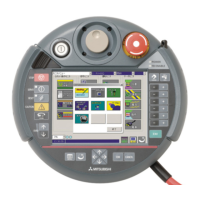50
3 TROUBLESHOOTING
3.3 Troubleshooting by Symptom
When the pulses are not measured correctly
When the PWM output is not correct
When the inter-module synchronization function does not
operate correctly
Check item Action
Check whether the shielded twisted pair cables are used for pulse input
wiring.
Use the shielded twisted pair cables for pulse input wiring.
Check whether any noise comes from the grounded part of the high-speed
counter module.
Separate the grounding cable of the high-speed counter module from the
grounded part. If the high-speed counter module touches the grounded part,
separate it.
Check whether measures against noise are taken for the adjacent devices
and inside the control panel.
Take noise reduction measures such as attaching a CR surge suppressor to
the magnet switch.
Check whether the distance between the high voltage device and pulse input
line is kept enough.
Bundle the pulse input lines separately from other lines in piping and tubing,
and keep a distance of 150mm or more between the pulse input lines and the
power line even inside the control panel.
Check whether the section of the pulse to be measured is corresponding to
the pulse measurement section setting
Correct the pulse measurement section setting to suit the section of the pulse
to be measured.
Check whether the program, if used for reading out the measured pulse value,
reads out the value in unit of 2 words (32 bits).
Read out it in unit of 2 words (32 bits).
Check whether the external wiring of the pulse measurement terminal is
normal.
Check the external wiring to correct the errors.
Check item Action
Check whether the CPU module indicates any error. If the CPU module indicates an error, refer to the troubleshooting in the
following manual.
MELSEC iQ-R CPU Module User's Manual (Application)
Check whether the counter operation mode is set to PWM output mode. Set the counter operation mode to PWM output mode in Basic setting.
Check whether a voltage is applied to the power supply terminal for external
output.
Apply a voltage to the power supply terminal for external output.
Check whether the external wiring of the PWM output point No.1 terminal
(EQU1) and PWM output point No.2 terminal (EQU2) is normal.
Check the external wiring to correct the errors.
Check whether anything other than a resistive load is connected to the PWM
output point No.1 terminal (EQU1) and PWM output point No.2 terminal
(EQU2).
Connect a resistive load because the output waveform is highly distorted by
connecting a load other than a resistive load.
Check whether the shielded twisted pair cables are used for PWM output
wiring.
Use the shielded twisted pair cables for PWM output wiring.
Check whether any noise comes from the grounded part of the high-speed
counter module.
Separate the grounding cable of the high-speed counter module from the
grounded part. If the high-speed counter module touches the grounded part,
separate it.
Check whether measures against noise are taken for the adjacent devices
and inside the control panel.
Take noise reduction measures such as attaching a CR surge suppressor to
the magnet switch.
Check whether the distance between the high voltage device and PWM output
line is kept enough.
Bundle the PWM output lines separately from other lines in piping and tubing,
and keep a distance of 150mm or more between the PWM output lines and
the power line even inside the control panel.
Check item Action
Check whether the high-speed counter module is set as the synchronization
target module in the system parameter setting of GX Works3.
Check "Module Synchronous Status" on the system monitor of GX Works3.
When "Module Synchronous Status" is displayed as "-", the high-speed
counter module is not set as the synchronization target module.
Set the high-speed counter module as the synchronization target module in
the system parameter setting of GX Works3.
Check that the CPU module is in the RUN status. If the CPU module is not in the RUN status, switch the status to RUN.
Check whether the inter-module synchronous interrupt program exists. If the inter-module synchronous interrupt program does not exist, add the
program.
Check whether the EI instruction is executed. Execute the EI instruction.

